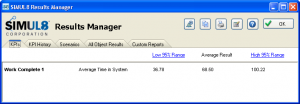For people new to simulation trials are something that’s often hard to get your head around. What are they? When should you use them?
The official definition of a trial is: “a series of runs of the simulation, performed with the same settings for all parameters other than random numbers.”
So what does that mean? It means your simulation is run multiple times back to back but with different random numbers each time. Usually when you press the run button in SIMUL8 the random numbers are not changed (random numbers are what gives the simulation the real world variability, I’ll explain them in another post at some point).
We keep the random numbers the same so that you can you make a change to your simulation, re-run the simulation and know that it’s the change you’ve made that’s impacted the results and not the new random numbers that have changed things. It’s like running the same day again and again but changing one thing to see if it gives a better outcome.
The downside of a single run though is that because you’re just running the same day again and again you could just be running a really good day again and again, and your solution might not hold up on a bad day. That’s where trials come in. When you run a trial the random numbers get changed in each run, so it’s like testing your solution out on lots of different days, some will be good and some will be bad days.
When you run a trial SIMUL8 reports results differently, so rather than getting single numbers you get averages with confidence intervals, like in the screenshot below:

This tells you that on average the amount of work that will be processed in your simulation is 68.50 and if it’s not 68.50 SIMUL8 is 95% confident that the average will lie between 36.78 and 100.22. That’s quite a large range, the more runs I do in my trial the more the bounds will narrow. The narrower the bounds the more confident I can be that I know how my solution will perform.
So when should you use a trial? You should always do trials in every simulation project. I might do them as a I validate my simulation, but I will always do them when my simulation is complete and I’m using my simulation to generate my proposed solution.
